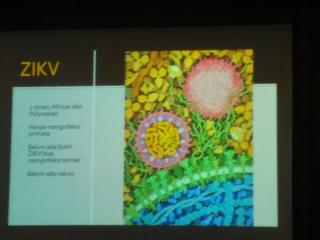Professor of IPB: Be Vigilant to Zika Virus

The spread of zika virus had been known since 1947 and firstly it was found in the monkeys in Africa. After that, this virus was known to spread to Asia. Hereinafter, in 2007 it was started to be a lot of infectious and erupted and at the end of 2014 until 2015 it was even still existed.
As if this virus never disappeared and reappeared. Until now, the zika virus infected the primates, there had no evidence of infected livestock and there was no vaccine. This virus was transmitted by the mosquitoes mainly Aedes aegypti (vector of dengue, yellow fever, chikungunya). Definitive or potential vectors were widely available in Africa, America, Asia, Europe and Pacific Islands.
According to the expert in the field of virus of the Faculty of Veterinary Medicine (FKH) of Bogor Agricultural University (IPB), Dr. Surachmi Setyaningsih, with the detection of zika virus in Singapore, Indonesia should be vigilant because of the potential for very high transmission, namely Aedes aegypti mosquito existed, the environment supported and the less caring people. “This is the risk factor that we consider to be important. Must be seriously worked on and could not be partial,” she said.
She said, this time Singapore had reported a zika virus attack on human. Because there was an issue that this virus had something to do with the babies to be born, they detected although the symptons were mild such as fever, red eyes, red spots (such as dengue). “We and Singapore are close, I guess the mosquitoes are not much different species with us. They which have good sanitation can be contracted, so we must be prepared and increase the vigilance,” she added.
The spread of zika virus should be watched out because the humans provided the habitat. Home environment and our surroundings were full with the containers of water that could lead to developing Aedes aegypti. There were used cans, there were leftover items that accumulated in our homes and became the breeding grounds for mosquitoes. All this time, the people already knew that they provided the water that could become the breeding ground for Aedes aegypti. However, the concern for the environment was very low. “The observation result of larvae in some areas shows that the free numbers of larvae in Bogor are still far from the standard of the government. On average, it is only reaching 17-18 percent,” added Prof.Dr. Upik Kesumawati, the expert in the mosquito in the FKH of IPB.
The research result showed that the Aedes aegypti was a formidable mosquito, not only it was able to lay the egg in the clear place, but also it could lay the egg in the polluted water. This mosquito was adaptable to the environment. The behavior of the Aedes aegypti mosquito was considered the daylight mosquito, apparently the research result found that this mosquito was discovered at night. This was a change of adaptive behavior of the Aedes aegypti.
According to Prof. Upik, it was easy to control the mosquito as long as we wanted. Taking control of the vector of the Aedes aegypti with 3M plus namely buried, drained and eliminated the container that contained water. Healthy lifestyle and clean environment. Cleaned the water reservoir, at least once a week and rubbed it until it was clean, because the eggs of the Aedes aegypti stuck to the wall of the container.
“The special thing of the Aedes aegypti eggs is that it can survive even if there is no water. The eggs are drought resistant, once there is the rainwater it will grow again. It is different with other mosquitoes, if there is no water they will die. The point is to close the water container,” she concluded.(Zul)



